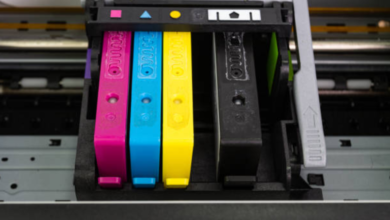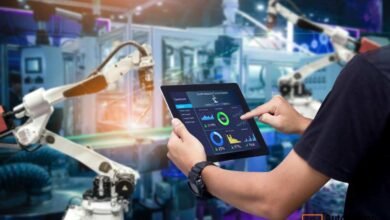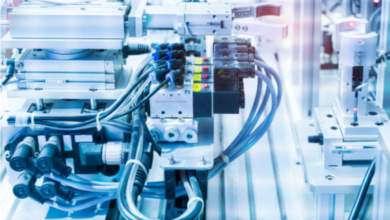
Retroreflective Sensors: A Compact Solution for Reliable Object Detection in Industrial Automation
In today’s factories, sensors are the eyes and ears of machines. They tell robots and conveyors what’s moving and what’s in place. One of the most space-saving and dependable choices is the retroreflective sensor. By bouncing light off a small reflector, these devices can spot an object without needing to touch it. This hands-free detection makes retroreflectives perfect for counting, lining up, or monitoring goods on an assembly line. As a result, they have become a mainstay in manufacturing, packaging, logistics, and even warehouse automation.
In this post, we will break down how retroreflective sensors operate, why they shine in industrial settings, where they are commonly used, and how suppliers like OMCH are helping customers set them up for smoother workflows and better efficiency.
Understanding Retroreflective Sensor Technology
At their core, retroreflective sensors belong to a larger family of photoelectric sensors. Each unit packs a small light emitter and receiver into a single housing while relying on a separate reflector mounted nearby. The sensor sends out a thin beam of either infrared or visible red light directed straight at the reflector. If a box, pallet, or any surface crosses the path of that beam, less light returns to the receiver. The sudden drop is quickly detected and converted into an output signal that can stop a motor, trigger a light, or log a count.
What makes retroreflective sensors really stand out is their clever use of a retroreflector. Unlike traditional through-beam or diffuse setups, this technology reflects the emitted light straight back to the built-in receiver. Because of that, you don’t need a separate receiver unit, which trims down both wiring clutter and the physical space the system takes up.
High sensing range means they can still work well in dusty factory aisles or when the shop-floor lighting flickers. Their polarizing filters let them spot tricky targets like clear plastic wrap or shiny glass bottles that might confuse other types of sensors. On top of that, they boast a fast response time, so they keep pace in high-speed automated lines.
With the emitter and receiver housed together, setting the sensor up and getting it aimed just right is a quick job. That ease of installation is a big plus in cramped industrial corners where every inch counts.
Why Retroreflective Sensors Matter in Industrial Applications
If you run a B2B operation in manufacturing, automation, or the supply chain, these sensors deliver some game-changing benefits:
- Space-Saving Design: One compact device cuts down installation time and leaves more room inside your control cabinet.
- Lower Cost of Ownership: Easy wiring plus little maintenance add up to cheaper, hassle-free operation over the long haul.
- Reliable Detection of Difficult Targets: Polarizing filters help the sensor catch clear or glossy materials that other models might ignore.
- Built to Brave the Elements: These sensors are tightly sealed to keep out moisture, dust, and vibration, so they thrive on busy factory floors where the environment can be tough.
- Sees Everything: They can spot all kinds of object surfaces—from dark cartons to shiny metal—so you don’t have to worry about what you’re trying to track.
Their quick response, flexibility, and low cost make retroreflective sensors the go-to choice for automated systems that need reliable, no-touch sensing.
If you’re thinking about upgrading your plant’s sensor setup or planning a new installation, OMCH has a wide range of retroreflective and other photoelectric sensors ready for you. You can check out their full lineup in this https://www.omchsmps.com/de/path/photoelectric-sensor/ dedicated to industrial photoelectric technologies.
See also: Organizing Research with AI: How Technology Helps Students Handle Large Data Sets
Where You’ll Find Them in B2B Workplaces
Retroreflective sensors pop up in many different industries. Here are a few of the most common places you’ll see them in action:
- Packaging Lines: They tell the system when a container, box, or bottle comes by, even if the item is clear plastic or glass.
- Automated Warehousing: They keep an eye on where bins are stored, help track pallets, and align guided vehicles with pinpoint accuracy.
- Textile Production: They spot fabric rolls and steer material feeds without ever touching those delicate surfaces that could be ruined.
Where Retroreflective Sensors Fit In
Retroreflective sensors are everyday workhorses on the factory floor. They make it easier for teams to keep product lines tidy, even when equipment is routinely washed down—think food-production plants that have strict hygiene rules. With an IP67 or higher rating, these sensors shrug off water and dust, allowing boxes, bottles, or trays to glide past without miscounts or messy backups.
They’re also hard at work beside robotic arms and Automated Guided Vehicles (AGVs). The moment a cart rolls into a loading bay or a robot swings into position, these sensors spot nearby obstacles and signal the controller—stopping or redirecting the machine before anything gets damaged.
Because they react quickly and handle changing light like champs, retroreflective sensors suit busy, fluctuating environments. From keeping a production line straight to tallying parts in motion, they help everyone finish a shift with fewer mistakes and higher output.
How to Pick the Right One
When it’s time to buy or upgrade retroreflective sensors, a handful of details will guide the decision:
- Sensing Distance: Check how far the sensor needs to ‘see’ the reflector. Most units cover ranges from about 10 centimeters to 10 meters, but some go farther.
- Target Surface: Is the target shiny, clear, or oddly shaped? Polarizing filters or colored light might be necessary to keep reflections from throwing off the read.
- Mounting Space: In cramped corners, a slim, low-profile sensor can save the day where a traditional unit won’t fit.
- Electrical Specs: Double-check that the sensor matches the rest of the system. Look at output type—NPN, PNP, or something else—voltage requirements, and the signal format.
- Shop Floor Conditions: Finally, factor in extremes: Will the sensor face high heat, damp air, constant shaking, or chemical sprays? The right protection rating means it will keep working instead of rusting out early.
- Response Time: When conveyor belts zip along or moving parts are in constant motion, you need sensors that can keep up. Fast switching and reliable detection are no longer optional; they’re a must.
That’s why B2B companies are wise to team up with suppliers who provide sample products, ready-to-use CAD files, and hands-on technical support. Those extras can dramatically cut integration time and help prevent mistakes when the system goes live.
How OMCH Is Shaping Smart Sensing for Today’s Factories
As Industry 4.0 takes root, OMCH remains a go-to source for cutting-edge sensing gear. Thanks to strict quality checks and a team that knows the ins and outs of automation, the company has built a broad line of sensors that stand up to real-world demands.
Their photoelectric sensor series features slim retroreflective units designed for toughness, speed, and easy installation. So whether a client is running a high-speed packing line or setting up a busy warehouse, OMCH can provide a scalable, wallet-friendly solution that gets the job done.
And sensors are just the start. OMCH also makes solid-state relays, temperature controllers, and power supplies, giving system builders, OEMs, and automation shops a one-stop shop for reliable parts.
If your company is looking for off-the-shelf sensing solutions, check out OMCH’s photoelectric sensor lineup. Their handy online catalog shows everything from product specs to dimension drawings and application notes, all written with business customers in mind.
Retroreflective sensors have become a go-to choice in fast-paced factory floors. They boost visibility, cut down on costly mistakes, and help keep production lines humming. Easy installation and steady performance—no matter the light or dust—mean you’ll find them in nearly every modern automation setup.
When businesses team up with trusted suppliers like OMCH, they can roll out sensors that satisfy strict industry standards while keeping systems flexible enough for tomorrow’s challenges.




